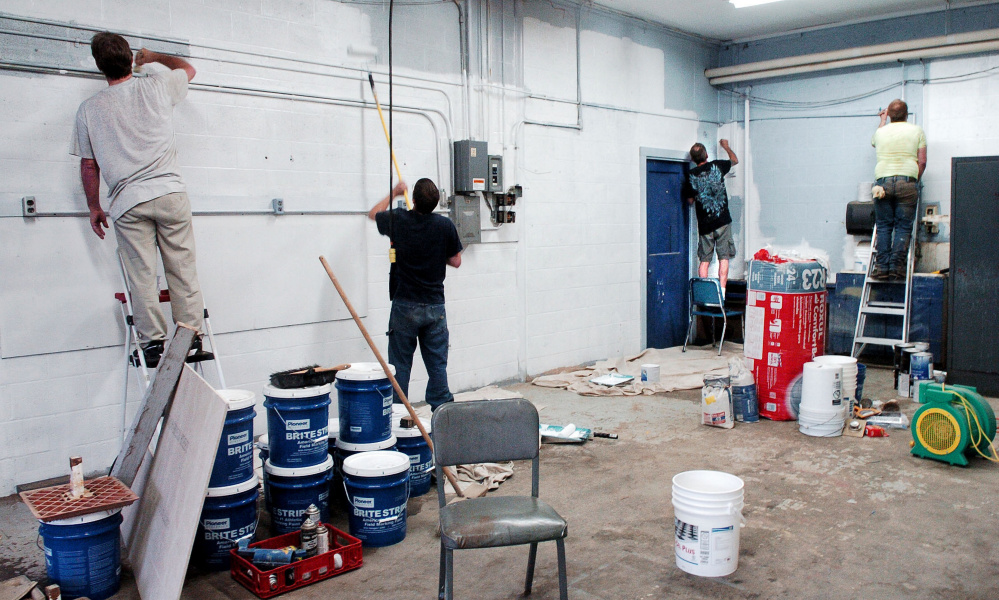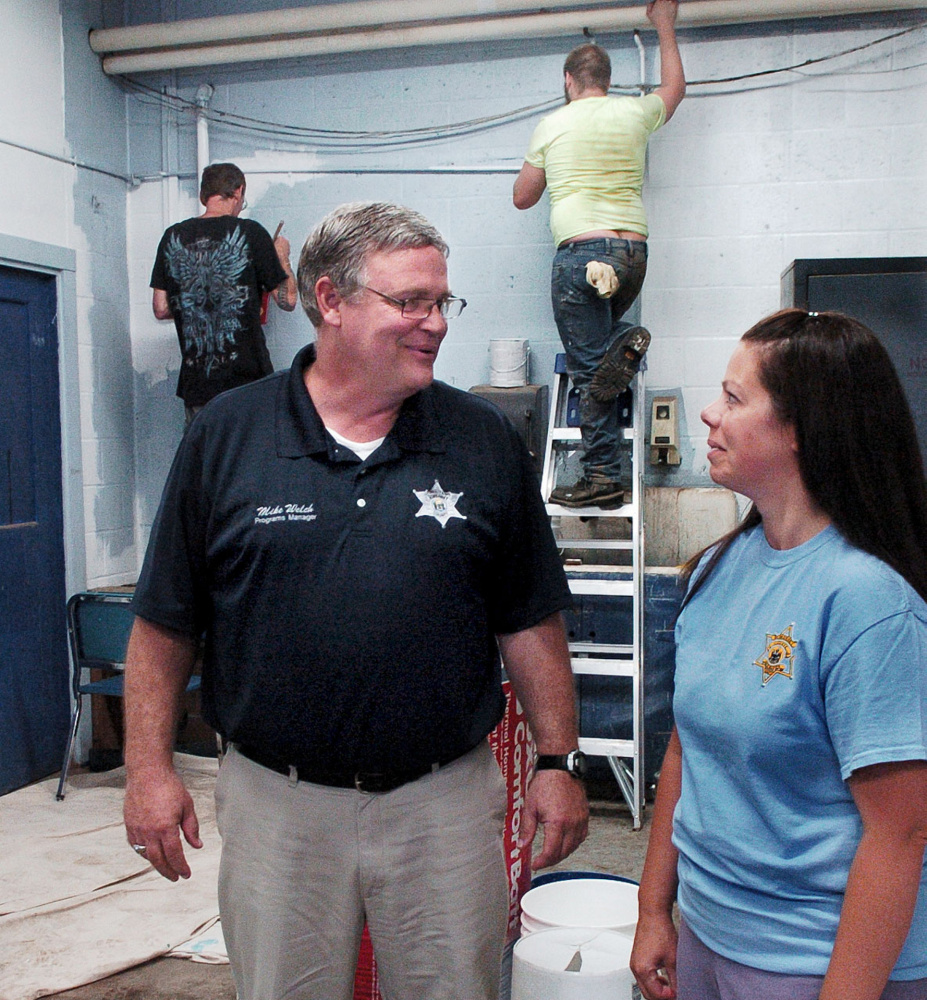After a judge found him guilty of operating under the influence, Marc Farrell, of Bradford, New Hampshire, faced a choice: He could either spend four days at the Somerset County Jail in East Madison or commit to a weekend of community service at a local junior high school.
Farrell, 56, chose to pay $225 to spend the weekend at Madison Junior High School, painting the school’s former industrial arts center along with a handful of others convicted of nonviolent minor offenses.
“It was less time for me and I’m also not lying in a jail cell staring at the ceiling,” Farrell said during a break from his second and last day of painting. “It may sound corny, but I’m in Alcoholics Anonymous now and I’ve been sober four and a half months. This is a way for me to give back to society.”
Farrell was one of four participants who recently completed the Somerset County Jail’s first alternative sentencing program, a new program that provides nonviolent offenders access to educational programs and the opportunity to do community service in place of a jail sentence.
Alternative sentencing is not unique to Somerset County – more than half of the county jails in Maine are involved in such programs – but there can be challenges to getting one started, said Teresa Brown, community corrections program supervisor for the jail in East Madison.
“It’s going to be a good thing,” said Brown, who added that the development of the program has been about a year in the making. “We’re saving the school money in manpower, and of course there’s the savings from these people not being in jail. Not only that, but it’s community service and they’re giving back. I think having these guys leave with a rewarding experience is more beneficial to them than sitting in jail for three days.”
GIVING BACK
The program is the first of its kind in Somerset County to offer community service as an alternative sentence. In 2014 the jail started its Alternative Substance Abuse Program, in which participants convicted of drug-related offenses spend up to one year in mental health and substance abuse treatment as an alternative to jail time, but that program targets a different jail population with more of an emphasis on treatment and behavioral modification for individuals struggling with substance abuse or addiction.
Some inmates also participate in regular community service through the jail’s work program, but they still spend most of their time at the jail.
In Kennebec County, which has had an alternative sentencing program for years, about 40 to 70 participants take part four times per year, said Kennebec and Somerset County District Attorney Maeghan Maloney.
“The beauty of this program is not only does it help with jail overcrowding, but the person is paying for their incarceration rather than having taxpayers pay for it,” Maloney said. “They’re giving back to the community, they’re paying for their time in custody and they’re learning about why their crime has a negative impact on the community.”
A vast majority of participants in alternative sentencing programs have been convicted of operating under the influence, according to Maloney, but the program in Somerset County is also open to other misdemeanor and nonviolent convictions for which someone is sentenced up to four days in jail.
The cost of participation is $225 for the weekend, something that Brown said she doesn’t see as a deterrent.
“If you were going to go to jail for four days, or you could pay $225, which would you rather do?” she said. “People are willing to pay for it.”
Farrell agreed. “Maybe if somebody was financially worse off it would be a deterrent, but for me it wasn’t a big deal,” he said. “It basically cut my time in half.”
The program is also expected to generate a small cost savings for taxpayers, as it eliminates the need for funds that would normally be spent on housing the participants of the program. The cost of housing an inmate for one day at the jail is about $90, according to Somerset County Sheriff Dale Lancaster.
“Not only does it pay for itself, but it also pays money because we’re not having to incarcerate,” Lancaster said.
Brown and Somerset County Jail Program Manager Mike Welch, who oversaw the first alternative sentencing program, are both salaried employees, so they were able to be scheduled to work the weekend without an additional cost. In the future they estimate the program will pay for itself with the cost of participation in the program.
CHALLENGES AT THE START
While the program is generally considered a win-win, Brown said there were some challenges in getting it started, including having to have the Maine Department of Corrections approve the community service site in advance and getting the community comfortable with the idea of having inmates working outside the jail. Other counties might also find it hard to staff larger programs, she said.
Counties that do not have alternative sentencing programs, according to the Maine Sheriffs’ Association, are Aroostook, Franklin, Hancock, Oxford, Piscataquis and Washington.
In Somerset County, inmates sleep on cots in a locker room at the middle school and in the evening attend speaking events with substance-abuse related experts – something that is not normally available to short-term inmates at the jail, where the first 72 hours are normally spent in the intake department going through the classification process.
“It was definitely interesting to hear other people’s point of view,” said one inmate, a local resident who did not want to give his name out of fear of losing his job. “It really opens up your eyes to how bad (addiction) can get.”
After reporting to Madison Junior High School Friday afternoon, the inmates spent all day Saturday and Sunday last week painting the school’s former industrial arts center. The job was a “significant” cost savings to School Administrative District 59, said interim Superintendent Bonnie Levesque, though she did not have an exact figure.
“I think it was great because it gave them something to do for the weekend while they served their time and it was a great service for us,” Levesque said.
By Sunday afternoon, the second coat of new white paint had almost been completely applied to the garage-like building and the four participants were cleaning up the area.
“Group dynamics are an important part of the program,” Welch said. “I think by working together they have a chance to interact and to learn that somebody else got caught for the same thing and the repercussions can be different. There were some that lost jobs, weren’t able to work anymore or lost their licenses. It affected them in different ways and hopefully they learn from each other’s experiences.”
“I think the four of us got along really well and worked really well together,” Farrell said. “The staff, too, treated us with respect and dignity. It made me want to do a really good job.”
Send questions/comments to the editors.






Success. Please wait for the page to reload. If the page does not reload within 5 seconds, please refresh the page.
Enter your email and password to access comments.
Hi, to comment on stories you must . This profile is in addition to your subscription and website login.
Already have a commenting profile? .
Invalid username/password.
Please check your email to confirm and complete your registration.
Only subscribers are eligible to post comments. Please subscribe or login first for digital access. Here’s why.
Use the form below to reset your password. When you've submitted your account email, we will send an email with a reset code.